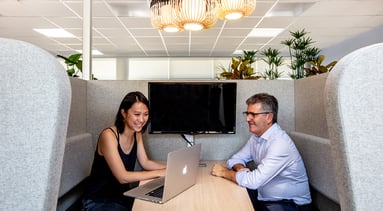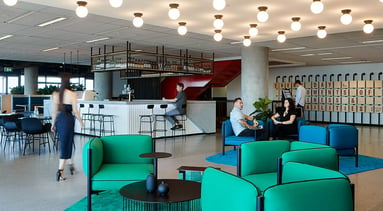The death of presenteeism and the rise of the self-managed workforce
3 minute read

The pandemic has forced countless organisations to offer employees more control over how and where they work – just what we need to solve the longstanding issue of presenteeism. But as physical offices start to open up again, what should employers be doing to avoid the problem from rearing its head once more?
Defining presenteeism isn’t straightforward. Some view it as showing up to work despite feeling physically or mentally unwell; others relate it to turning up excessively early and staying late because of underlying job insecurities. It has even been described in terms of FOMO (fear of missing out).
But whatever your definition, presenteeism has been affecting business productivity for decades and, by 2019, four out of every five businesses were reporting instances in their workplace.
However, when the first wave of Covid lockdowns hit, in-office presenteeism was instantly reduced to its lowest level in years thanks to enforced office closures and stay-at-home orders.
As Steve Quick, Global CEO at Unispace explains, “Every progressive business knows that there’s little value in employees showing up to work when unfit, or staying in work for far longer than necessary. But it’s taken the mass shift to remote working – combined with a prominent public health discourse around Covid – to finally create the conditions to crack the problem of presenteeism once and for all.”
Letting results speak for themselves
Three quarter of employees claim to have matched or exceeded in-office productivity levels while working from home – an impressive figure given the extra distractions provoked by the pandemic.
“Once you give employees more autonomy over how and when they ‘show up’, you find that they become more productive, more motivated, and often much healthier,” explains Quick. “All of a sudden they can devise working routines that better suit their daily life rather than spending every last hour in the office, irrespective of how they’re feeling or other non-work pressures they’re facing.”
Perhaps most interestingly, 74% of employees now endorse the idea of having a limited number of core hours per day where they are ‘available’ to colleagues, with the opportunity to work to their own schedules the rest of the time.
Such a change would represent a huge shift from established business norms, however, if the pandemic has shown us anything, it’s that rapid change is absolutely achievable where there’s a clear rationale – and internal support – for doing so.
Meeting the in-office needs of the self-managed workforce
The big question now is what happens when physical offices start to reopen again? Having made great strides in addressing presenteeism, the onus is now on organisations to avoid repeating past mistakes and build a working culture that continues to support employee choice, autonomy and ‘self-management’.
At Unispace, where we’ve built our own culture around these principles for many years already, our Propeller framework considers the idea that offices will be occupied far less than in the pre-Covid era. It outlines a number of ways in which organisations can reconfigure their space to satisfy employees’ social and collaboration needs and function more as an idea and revenue generator, rather than a place where people feel obliged to show up every day.
“Employers need to give these self-managed employees a genuine choice of when to come into the office versus when to work from home,” says Quick. “Crucially, the physical office should be the place they visit to get inspired and bounce ideas off their colleagues and friends, rather than a room full of desks where everyone keeps their head down from 9-5 each day.”
Take the idea of dividing the day into ‘available’ versus ‘non-available’ working hours. If available hours are spent in the office, employers will have less need for quiet zones and private booths, and can redesign their environment with an emphasis on collaboration, socialisation and hospitality amenities designed to bring colleagues, clients and partner organisations together. Remember that the concept of ‘skiving’ is consigned to the waste bin with this model, for an employee who is demonstrably able to self-manage will always have justification for downtime spent with colleagues.
Employers will also have to plan their spaces carefully to avoid favouritism creeping in towards those who show up in person. For example, at PwC every meeting is now virtual by default, meaning that people attend via laptop even if they are physically in the room. Bigger meeting spaces, with better acoustics and improved AV capabilities, could be a smart move to keep everyone on the same level.
There are also practical repercussions - such as social distancing and Covid-compliance regulations – to be factored into spatial considerations. Even with a self-managed workforce, policies may still be required around office access and when it’s required, optional, or unnecessary, so that the reconfigured workplace can effectively, safely support those in attendance.
The battle against presenteeism isn’t over
While there is much cause for optimism, sadly, there have also been reports throughout the pandemic of employees feeling pressured into coming into the physical workplace.
Similarly, almost half of UK remote workers reported feeling more pressure to be ‘present’ online during lockdown. It is no good solving the problem of in-person presenteeism, only to replace it with a virtual variant.
“These new forms of in-person and virtual presenteeism must be called out and stamped out before they become widespread,” adds Quick. “Remote-based employees should be judged on the results they deliver, and not the speed at which they respond to their Slack notifications or how often they’re physically seen in the office.”
Clearly, employees must do their bit to demonstrate that they can be trusted to self-manage effectively. But with months of further Covid-disruption likely, it’s time for employers to embrace this flexible, progressive approach to workforce management, adapting their physical working environments accordingly, and eliminating the costly issue of presenteeism once and for all.


